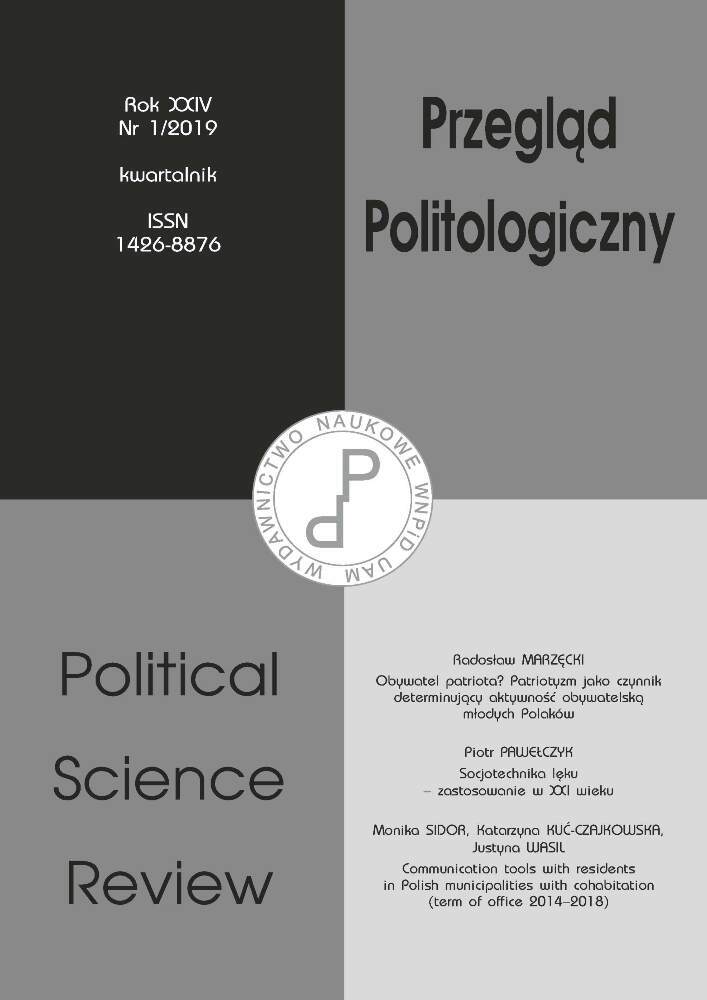Abstract
The existence of separatist and disintegrating movements in Europe, hot spots and armed conflicts, argues that our continent is neither peaceful nor safe place. Even if we consider it the safest place on our planet. After 1989, democracy prevailed in Europe, in 1999–2013 the Central and Eastern European countries were included into the Western defence (NATO) and economic (EU) structures, with great hopes for the future. In the second decade of the twenty-first century completely different tendencies appeared in Europe. Separatist and populist movements intensified their activity in almost all European countries (Rostowska 2018). The article raises the following research questions:1. What is the source of separatist-populist movements?
2. What is the basis of the revival of nationalism in European countries?
3. Why is the policy of autonomous autonomy not working?
4. What can be the result of the ethnic disintegration of other countries in Europe? The article uses the comparative method and system analysis. Analyzing the problem, the author came to the following conclusions:
1. There are problems in Europe that have led and may lead to wars.
2. No state can feel safe even if it is stable and democratic.
3. Extremist political parties and movements may destabilize the continent.
4. The only antidote in calming conflicts and eliminating separatist situations is a well-established and stable democracy.
5. European policy (EU) should be unambiguous and stable in this matter.
References
Chwalba A. (2011), Historia Powszechna 1981–2011, Warszawa.
Czaja J. (2008), Kulturowe czynniki bezpieczeństwa, Kraków.
Dobraczyński M., Stefanowicz J. (1979), Tożsamość Europy, Warszawa.
Gellner E. (1991), Narody i nacjonalizm, przeł. T. Hołówka, Warszawa.
Grgies A. (1995), Sprawa kurdyjska w XX w., cz. I, II i III, Instytut Spraw Międzynarodowych UW, Warszawa.
Grott B. (1999), Nacjonalizm chrześcijański. Narodowo-katolicka formacja ideowa w II Rzeczypospolitej na tle porównawczym, Krzesłowice.
Heywood A. (2006), Politologia, Warszawa.
Kuczyński M. (2001), Krwawiąca Europa konflikty zbrojne i punkty zapalne w latach 1990–2000. Tło historyczne i stan obecny, Warszawa.
Jackson R. (2011), Suwerenność, Warszawa.
Matusiak E. (2007), Narody Północnego Kaukazu. Historia – kultura – konflikty 1985–1991, Toruń.
Michałowska G. (2010), Dyferencjacja cywilizacyjno-kulturowa świata a jedność porządku międzynarodowego, w: Świat wobec współczesnych wyzwań i zagrożeń, red. J. Symonides, Warszawa.
Piwnicki G. (2007), Wpływ traumatycznych doświadczeń Polaków i Niemców z okresu II wojny światowej na normalizację stosunków bilateralnych w jednoczącej się Europie po wstąpieniu Polski do Unii Europejskiej, w: Kształtowanie się Nowego Ładu Międzynarodowego, red. A. Chodubski, M. Malinowski, E. Polak, P. Trawicki, Gdańsk.
Piwnicki G. (2016), Przyszłość bezpieczeństwa społecznego Unii Europejskiej w globalnej rzeczywistości XXI wieku przez pryzmat megatrendu minimalizacji kosztów pracy i robotyzacji, „Cywilizacja i Polityka”, nr 14, Toruń.
Piwnicki G. (2017), Syndrom reintegracji w stosunkach Polski z Unią Europejską po roku 2015, „Cywilizacja i Polityka”, nr 15.
Nacjonalizm kontra światowy ład. Co będzie górą?, „The Wall Street Journal” 22.01.2018, tłum. Agnieszka Rostkowska.
Stasiński M., ETA się rozwiązuje, ale nie kaja, „Gazeta Wyborcza” z dn. 20.04.2018.
Tomaszewski W., http://wolnosc24.pl (odczyt: 15.03.2018 r.).
Waniek D. (2014), Ruch narodowy w Polsce wczoraj i dziś, ideologia, organizacja, praktyka działania, Warszawa.

